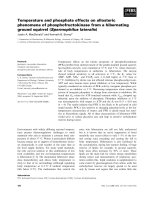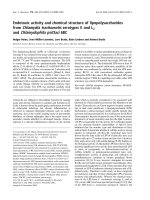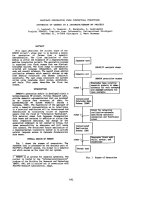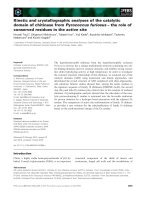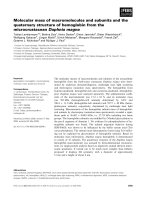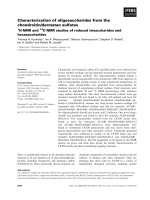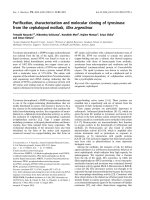Management ownership structure, audit quality and impairment of assets--evidence from China
Bạn đang xem bản rút gọn của tài liệu. Xem và tải ngay bản đầy đủ của tài liệu tại đây (8.76 MB, 259 trang )
MANAGEMENT OWNERSHIP STRUCTURE, AUDIT QUALITY AND
IMPAIRMENT OF ASSETS - EVIDENCE FROM CHINA
by
Wong Wai Yee, Pauline
A thesis
submitted in partial fulfillment
of the requirements for the Degree of
Doctor of Philosophy
School of Accounting and Finance
The Hong Kong Polytechnic University
December 2007
UMI Number: 3313064
INFORMATION TO USERS
The quality of this reproduction is dependent upon the quality of the copy
submitted.
Broken or indistinct print, colored or poor quality illustrations and
photographs, print bleed-through, substandard margins, and improper
alignment can adversely affect reproduction.
In the unlikely event that the author did not send a complete manuscript
and there are missing pages, these will be noted. Also, if unauthorized
copyright material had to be removed, a note will indicate the deletion.
®
UMI
UMI Microform 3313064
Copyright 2008 by ProQuest LLC.
All rights reserved. This microform edition is protected against
unauthorized copying under Title 17, United States Code.
ProQuest LLC
789 E. Eisenhower Parkway
PO Box 1346
Ann Arbor, Ml 48106-1346
CERTIFICATE OF ORIGINALITY
I hereby declare that this thesis is my own work and that, to the best of my
knowledge and
belief,
it reproduces no material previously published or written, nor
material that has been accepted for the award of any other degree or diploma,
except where due acknowledgement has been made in the text.
(Signed)
WONG Wai Yee. Pauline (Name of student)
Abstract
Management Ownership Structure, Audit Quality and Impairment of Assets
—
Evidence from China
by
Wong Wai Yee, Pauline
Doctor of Philosophy
Following the release of 1998 Accounting Standards, Chinese regulatory
authority further implemented another set of regulations in 2001 governing the
write-down of impaired assets and requiring an assessment of recoverable amount
on four additional categories of assets. Since the recoverable value is difficult to
obtain objectively, management can discretionally assess the magnitude of
write-down to affect the bottom-line profit. Using a sample of
5,399
firm-year
observations in China from 1998 to 2004,1 examine whether the percentage of asset
write-down by state-controlled firms differs from non-state-controlled firms in
China, conditional on more conservative financial reporting rules. Moreover, I
investigate whether local auditors, who are more likely subject to political influence
from local governments, will support managerial decisions on asset write-down.
My empirical findings support that the companies controlled by state would be less
sensitive to economic losses, as compared to companies dominated by holders of
non-state shares. In addition, I also find that local auditors support managerial
decisions on asset write-down.
Chinese regulators realize that companies may use provision for asset
write-down and its reversal to build up big-bath and to smooth reported income.
Therefore, the 2006 Accounting Standards forbid the reversal of recognized asset
impairment provision on long-term investments, fixed assets, construction in
progress, and intangible assets, effective from 2007. I examine whether incentives
including controlling ownership by state and audit quality of small domestic
auditors located in the region of their clients will affect reversal of recognized
provision for asset write-down during the transition period. My empirical findings
show that state controlled companies tend to have weak incentive in reporting asset
impairment reversal, conditional on positive stock returns or positive cash flows.
Companies controlled by state tend to reverse more impairment provisions, as
compared to companies dominated by holders of non-state shares. Furthermore,
ocal small auditors are more likely to agree with the aggressive accounting
treatment on impairment reversal of their clients.
ACKNOWLEDGEMENTS
My ultimate appreciation must go to my supervisors, Dr. Jiang Li, Professor
Phyllis L. L. Mo, and Dr. Donghui Wu, for their thorough guidance on my
dissertation. I would not be able to reach this stage without their talents, patience
and continuous encouragement. I appreciate the financial support provided by the
School of Accounting and Finance of the Hong Kong Polytechnic University, which
makes it possible for me to complete my studies. I cannot thank them all in this
limited space, but I would like to express my gratitude to the following academic
professionals, Professor Ferdinand Gul, Professor Jeong Bong Kim, Professor Bin
Srinidi, Professor T.J. Wong, Dr. Shimin Chen, Dr. Peter Cheng, Dr. Agnes Lo, Dr.
Raymond Wong, Dr. Xiaodong Xu and other academic colleagues and professionals
for their advices on my thesis. Thanks are due to Kevin Ding, Joseph Mak, Roger
Lui,
Shauna Shi, Byron Song and Kevin Zhu for their technical wizardry in working
with regression techniques and other software issues.
Big thanks to the Asia Pacific Conference on International Accounting
Issues for awarding the "Vernon Zimmerman Best Paper Award" on an earlier
version of this thesis. It is a priceless support. I also wish to thank the
participants of the 18
th
Asia Pacific Conference on International Accounting Issues,
and the 2007 AAA Western Region Annual Conference for their comments.
Thanks to my Godmother, Wendy, and the godparents of my sister, Irene and
Peter, who buoyed me through countless nice meals. Special thanks to the
Reverend Father Franco Bellati, the Reverend Father Robert J. Cook, the Reverend
Father Francesco Cumbo, the Reverend Father Gabriel Y.T. Liu, the Reverend
Father Joseph K.H. Mak, the Reverend Father Paul M.J. Vallat, and the Reverend
Father Edward F.M. Yu, and sisters and brothers at the St. Stephen's Parish and the
St. Thomas the Apostle Church in Hong Kong, who had helped co-ordinate the
Requiem Mass and funeral of my mother in July this year. I am especially grateful
to my friends and their extended families in Boston, MA., Malaysia, Singapore,
Toronto, ONT., La Crosse, WL, and the mainland China and Taiwan. They always
remember me in their prayers. I am blessed having them in my life. A special
word of thanks to Professor K.H. Chan, Professor C.K. Wong, and Dr. Michael C.H.
Kwok, who play perfect role as mentors of my sister and me. I would especially
like to thank my little sister, Venus, for her love, encouragement, tireless support
and patience. This dissertation is dedicated to my late parents, Maria and Joseph.
They had always encouraged me to pursue studies and had sacrificed many to make
my education possible. I thank God for everything.
"I give my parents back to you, O
Lord,
who first gave them to me;
And as You did not lose them in the giving,
so I do not lose them in the return."
Management Ownership Structure, Audit Quality and Impairment of Assets
- Evidence from China
Certificate of Originality
Abstract
Acknowledgements
Table of Contents i
List of Figure vi
List of Tables vi
Chapter 1 Introduction
1.1 Motivation for the Research 1
1.1.1 The Role of Accounting Standards in Conservative
Financial Reporting 1
1.1.2 The Role of Accounting Standards in Conservative
Financial Reporting in China 1
1.1.3 Significance of State Ownership 4
1.1.4 Significance of State Ownership in China 5
1.1.5 Significance of Audit Quality 6
1.1.6 Significance of Audit Quality in China 7
1.2 Objectives of the Thesis 9
1.3 Contributions of the Thesis 10
1.4 Organization of the Thesis 11
Chapter 2 State Ownership, Audit Quality and Earnings
Management in China
2.1 Ownership Structure of Listed Companies in China 13
2.2 Audit Quality in China 15
I
2.3 Profitability Requirement for Listed Companies 21
2.3.1 Maintenance of Listing Status 21
2.3.2 Regulations on Rights Issues 23
2.4 Earnings Management Incentives 29
2.5 Accounting Regulations on Asset Impairments 34
2.5.1 Accounting Standards in Developed Economies 34
2.5.2 Accounting Standards in China 34
2.5.2.1 Accounting Standards before 1998 34
2.5.2.2 1998 Accounting Standards 35
2.5.2.3 2001 Accounting Standards 38
2.5.2.4 2006 Accounting Standards 39
Chapter 3 Literature Review
Chapter Summary 42
3.1 Literature Review on Asset Impairments 43
3.1.1 Literature Review on Asset Impairments in Developed
Economies 43
3.1.2 Literature Review on Asset Impairments in China 44
3.2 Literature Review on State Ownership 45
3.2.1 Literature Review on State Ownership in Developed
Economies 45
3.2.2 Literature Review on State Ownership in Asian Countries 46
3.2.3 Literature Review on State Ownership in China 47
3.3 Literature Review on Audit Quality 48
3.3.1 Proxies for Audit Quality 48
3.3.1.1 Audit Firm Size 48
3.3.1.1.1 Big Eight/Six/Five/Four Audit Firms 49
3.3.1.1.2 Clients Sales 51
3.3.1.1.3 Clients Assets 51
3.3.1.1.4 Number of Clients 52
3.3.1.1.5 Audit Fees 52
3.3.1.2 Auditor Brand Name Reputation 5 3
3.3.1.3 Industry Specialization 54
3.3.1.4 Audit Tenure and Audit Firm/Partner Rotation 5 5
n
3.3.1.5 Audit Contract Type 56
3.3.1.6 Modified Audit Opinions 57
3.3.1.7 Non-Audit Service 57
3.3.1.8 Audit Failures 58
3.3.1.9 Political Influence from Audit Clients 59
3.3.2 Previous Research on Audit Quality in China 59
Chapter 4 Are State Ownership and Auditor Locality Determinants
of Asset Write-Down?
Chapter Summary 63
4.1 Introduction 65
4.2 Hypotheses Development 70
4.2.1 Economic Factors 70
4.2.1.1 Stock Returns 70
4.2.1.2 Cash Flows from Operations 73
4.2.2 Incentives Factors 74
4.2.2.1 State Controlled Firms 74
4.2.2.2 Audit Quality 76
4.2.3 Regulator y Factors 81
4.2.3.1 Delisting Avoiders 82
4.2.3.2 Rights Offering Qualifiers 83
4.2.3.3 Big Bath Takers 85
4.3 Research Methodology 88
4.3.1 Sample Selection 88
4.3.2 Empirical Models 90
4.3.2.1 Basu (1997) Model 91
4.3.2.2 Ball and Shivakumar (2005) Model 100
4.3.3 Descriptive Statistics 102
4.4 Empirical Results 103
4.4.1 Basu (1997) Model 103
4.4.2 Ball and Shivakumar (2005) Model 107
4.5 Robustness Tests 110
4.5.1 Alternative Definition of Controlling Ownership 110
4.5.2 Alternative Definition of Local Auditors 111
in
4.6 Chapter Conclusion
112
Chapter 5 Do Firms Use Impairment Reversals to Meet Earnings
Targets?
Chapter Summary 115
5.1 Introduction 117
5.2 Hypotheses Development 123
5.2.1 Economic Factors 123
5.2.1.1 Stock Returns 123
5.2.1.2 Cash Flows from Operations 124
5.2.2 Incentives Factors 125
5.2.2.1 State Controlled Firms 125
5.2.2.2 Audit Quality 127
5.2.3 Regulator y Factors 132
5.2.3.1 Delisting Avoiders 132
5.2.3.2 Rights Offering Qualifiers 133
5.2.3.3 Big Bath Takers 134
5.3 Research Methodology 137
5.3.1 Sample Selection 138
5.3.2 Empirical Models 139
5.3.2.1 Basu (1997) Model 140
5.3.2.2 Ball and Shivakumar (2005) Model 150
5.3.3 Descriptive Statistics 153
5.4 Empirical Results 154
5.4.1 Basu (1997) Model 154
5.4.2 Ball and Shivakumar (2005) Model 157
5.5 Robustness Tests 159
5.5.1 The Tobit Specifications 159
5.5.2 Alternative Definition of Controlling Ownership 160
5.5.3 Alternative Definition of Local Auditors 161
5.6 Chapter Conclusion 161
Chapter 6 Conclusion and Discussion
6.1 Summary of the Results 164
IV
6.2 Implications 166
6.3 Limitations 167
6.4 Future Extensions of this Research 168
Figure 170
Tables 171
References 231
v
LIST OF FIGURE
Figure 1-1 Audit Market in China 170
LIST OF TABLES
Table 1-1 Average Annual Percentage Growth of Real GDP 171
Table 2-1 Stock Market in China 172
Table 2-2 Licensed CPA Firms to Audit Listed Companies in China as at 175
December 31, 2005
Table 2-3 Licensed CPA Firms to Audit Listed Companies in China as at 177
December 31, 2006
Table 2-4 Top-100 Auditors - Ranked by Fee Income 179
For Years 2002-2005
Table 2-5 Top-100 Auditors - Ranked by Number of CPAs 180
For Years 2002-2005
Table 2-6 Analysis of Audit Opinions on Listed Companies in China 181
For Years 1992-2005
Table 2-7 Accounting Treatment on Asset Impairment 182
Table 4-1 Descriptive Information on Sample Selection 183
Table 4-2 Descriptive Statistics on Variables Used in the Basu Model 185
Table 4-3 Descriptive Statistics on Variables Used in the Ball and 187
Shivakumar Model
VI
Table 4-4 Regression Results on Asset Write-down (Basu Model) For 189
Years from 1998 to 2004
Table 4-5 Regression Results on Asset Write-down (Ball and 191
Shivakumar Model) For Years from 1998 to 2004
Table 4-6 Regression Results on Asset Write-down (Basu Model) - 193
Alternative Definition of Controlling Ownership
For Years from 1998 to 2004
Table 4-7 Regression Results on Asset Write-down (Ball and 195
Shivakumar Model) - Alternative Definition of Controlling
Ownership
For Years from 1998 to 2004
Table 4-8 Regression Results on Asset Write-down (Basu Model) - 197
Alternative Definition of Top-10 Auditors (ranked by the
number of audit clients)
For Years from 1998 to 2004
Table 4-9 Regression Results on Asset Write-down (Ball and 199
Shivakumar Model) - Alternative Definition of Top-10
Auditors (ranked by the number of audit clients)
For Years from 1998 to 2004
Table 5-1 Descriptive Information on Sample Selection 201
Table 5-2 Descriptive Statistics on Variables Used in the Basu Model 203
Table 5-3 Descriptive Statistics on Variables Used in the Ball and 205
Shivakumar Model
Table 5-4 Tobit Regression Results on Reversal of Recognized Asset 207
Impairment Provision (Basu Model) For Years from 2001 to
2005
vii
Table 5-5 Tobit Regression Results on Reversal of Recognized Asset 210
Impairment Provision (Ball and Shivakumar Model) For Years
from 2001 to 2005
Table 5-6 OLS Regression Results on Reversal of Recognized Asset 213
Impairment Provision (Basu Model) For Years from 2001 to
2005
Table 5-7 OLS Regression Results on Reversal of Recognized Asset 216
Impairment Provision (Ball and Shivakumar Model) For Years
from 2001 to 2005
Table 5-8 Tobit Regression Results on Reversal of Recognized Asset 219
Impairment Provision (Basu Model) - Alternative Definition of
Controlling Ownership
For Years from 2001 to 2005
Table 5-9 Tobit Regression Results on Reversal of Recognized Asset 222
Impairment Provision (Ball and Shivakumar Model) -
Alternative Definition of Controlling Ownership
For Years from 2001 to 2005
Table 5-10 Tobit Regression Results on Reversal of Recognized Asset 225
Impairment Provision (Basu Model) - Alternative Definition of
Top-10 Auditors (ranked by the number of audit clients)
For Years from 2001 to 2005
Table 5-11 Tobit Regression Results on Reversal of Recognized Asset 228
Impairment Provision (Ball and Shivakumar Model) -
Alternative Definition of Top-10 Auditors (ranked by the
number of audit clients)
For Years from 2001 to 2005
vm
CHAPTER 1
INTRODUCTION
1.1 MOTIVATION FOR THE RESEARCH
1.1.1 The Role of Accounting Standards in Conservative Financial Reporting
Recent studies emphasize that accounting standards only partially influence
accounting properties, and it is the preparers' incentives that determine the quality
of accounting information (Ball et al.,
2003;
Ball and Shivakumar, 2005). In fact,
institutional features of a country influence the ownership and governance of
enterprises, which shape the preparers' incentives to report accounting information.
Market forces and government's involvement play important roles in determining
the institutional features. In other words, the demand for financial reporting by the
public and the government's participation in setting and enforcing rules and
standards affect the ownership structure of enterprises and in turn their incentives of
reporting.
1.1.2 The Role of Accounting Standards in Conservative Financial Reporting
in China
1
The National Bureau of Statistics announced that Gross Domestic Products
(GDP) of China for 2006 grew by 10.7 percent to reach RMB 20.94 trillion,
equivalent to US$2.68 trillion and the Chinese economy, which overtook Britain in
2005 to become the world's fourth biggest, is moving closer to that of Germany,
which is estimated to have grown by 2.2 percent last year to US$2.86 trillion {China
Daily, 26 January 2007). Table 1-1 summarizes the average annual percentage
growth rate of real GDP in China and other developed countries. The International
Monetary Fund (IMF) releases annual report on GDP and the GDP growth rates for
developed economies and emerging markets round the world. As reported in the
IMF 2007 report, the average 10-year growth rates for 1989 to 1998 and for 1999 to
2008 (projected) for China is 9.6 percent and 9.4 percent respectively, as compared
to 3.2 percent and 4.4 percent for the world average, and 3.0 percent and 2.8 percent
for the United States. In order to continue the growth and to attract foreign
investment, Chinese enterprises have to develop modern governance system and to
provide confidence to investors.
(Insert Table 1-1 about here)
To improve the quality of accounting information in order to attract more
investors in local enterprises, Chinese authorities issue accounting regulations and
2
accounting standards with reference to international standards. By introducing
asset write-down regulations in 1998 and 2001, the Chinese government aims at
enhancing the usefulness of the information reported on financial statements.
However, the decision of writing down the value of assets and the magnitude of
write-down allow management of listed companies to exercise discretion in
determining the recoverable value of relevant assets and provides a good chance for
management to opportunistically manage the reported earnings. Li (2001) shows
that, when the policy of asset write-down is compulsory, listed companies with loss
aversion, rights issues, and threshold motivations tend to increase (or, not to
decrease) the current earnings by lower asset write-down. Since asset write-down
will affect the reported profits and thus the listing status, the Accounting System for
Shareholding Companies of 1998
("1998
Accounting Standards") and the
Accounting System for Business Enterprises of
2001
("2001
Accounting Standards")
provide opportunities to management of listed companies to manage earnings. To
reduce firm's earnings management behaviors, Chinese regulators attempt to tighten
accounting standards. On February 15, 2006, the Ministry of Finance (MOF)
issued a new set of Accounting Standards for Business Enterprises
("2006
Accounting Standards") which will become mandatory for all listed companies in
3
China on January 1, 2007. The 2006 Accounting Standards disallow any reversals
of impairment provision on fixed assets and intangible assets, effective from 2007.
In addition, the 2006 Accounting Standards further requires listed companies to
justify any reversal during the transition period of 2005 and 2006.
1.1.3 Significance of State Ownership
Financial crisis and the Great Depression after the World War I brought an
increase in demand for greater social control over markets (Perotti, 2004).
However, the inefficiency of state-owned enterprises (SOEs) led to debates on the
government ownership for decades. Perotti (2004) documents two arguments,
public commitment problem and private commitment problem, used for justifying
state ownership in the presence of market failures. Public commitment problem
arises from the inability of the government to commit to regulatory policies, which
reduces private investment. Private commitment problem is arising from the
inability of government to control important decisions by private owners (Hart et al.,
1997;
Shleifer and Vishny, 1994). Sappington and Stiglitz (1987) suggest that
government may want to retain direct control to avoid costly contract renegotiation
processes with private parties.
4
Perotti (2004) also reports the inefficiency of SOEs, including a lack of
managerial and employee incentives to efficiency, problems of competence or
corruption by state authorities, and the use of SOEs for political purposes.
Megginson and Netter (2001) and Gong et al. (2006) argue that private ownership is
more appropriate than public ownership as it is easier to have a well-defined and
stable corporate goal. The results of prior literature on comparing the performance
of private enterprises and SOEs are mixed. Megginson and Netter (2001)
conclude that empirical work on this area faces the problem of selection bias, which
is arising from the factors affecting the enterprises to be state-owned or privately
owned and influencing the performance of the enterprise. Therefore, the
significance of state ownership remains an interesting area of research.
1.1.4 Significance of State Ownership in China
Economic reforms have transformed China from a centrally planned
economy and have brought out restructuring of ownership structure in enterprises
from contractual leasing, collectively-owned Township-Village Enterprises to
investor-owned public enterprises (Zhang, 2001). Enterprises controlled by
ministries or government agencies were transformed to become shareholding
5
companies. In July 1992, the State Council issued the Regulations on
Transforming the Management Mechanism of State-Owned Industrial Enterprises
and introduced the shareholding system. The establishment of the Shanghai Stock
Exchange (SHSE) in 1990 and the Shenzhen Stock Exchange (SZSE) in 1991
provided a platform for enterprises to list their shares.
Although shares of SOEs are allowed to be traded on the exchanges, the
state retains the ultimate control of the companies and reforming to market-oriented
economy according to the idea of "Socialism with Chinese characteristics".
Furthermore, the ministries and local governments transfer productive assets and
expertise from non-listed SOEs to establish a listed enterprise. In order to achieve
their social targets and to recover the cost of assets transferred, the state has to
retain control of the listed companies.
1.1.5 Significance of Audit Quality
Prior studies suggested that high quality auditors act as one of the effective
deterrents to earnings management by detecting and revealing misreporting by
management (Becker et al., 1998) and Big Six audit clients used more conservative
accounting methods (Chung et al.,
2003;
Basu et al., 2002). High quality auditors
6
help reducing information asymmetry between the owners and managers of a
company (Jensen and Meckling, 1976; Watts and Zimmerman, 1986). DeFond
and Jiambalvo (1993) present that when there is auditor-client disagreement, the
recommended course of auditors will lead to lower earnings as compared with the
treatment of management. Basu et al. (2002) find that auditors' conservatism
associates positively with levels of litigation against auditors. Research on auditor
behavior can help identifying factors to improve or maintain auditors' quality in
different institutional settings.
1.1.6 Significance of Audit Quality in China
In China, audit market is still dominated by small-scaled domestic CPA
firms and is not fully opened to international accounting firms. Chan et al. (2006)
find that local auditors have greater economic dependence on local clients and tend
to issue clean auditor opinions to companies owned by local government.
International large audit firms enjoy a substantial share of audit market. Liu and
Zhou (2007) report that senior officials of Chinese government believe Big 5 audit
firms provide much higher quality auditing service than local firms and therefore
allocate some market shares exclusively to international well-recognized audit firms.
7
On January 12, 2001, the China Securities Regulatory Commission (CSRC) and the
MOF jointly released the "Administrative Measures on Temporary License for
Overseas Certified Public Accountants' Firm When Executing Audit Business on
Financial Listed Companies" and required annual accounts of all listed companies
in Finance and Insurance Industry be audited by one of the Big 5 audit firms and a
local audit firm. On December 30, 2001, CSRC issued the 'Wo. 16 Rules on
Compilation of Information Disclosure of Companies That Make Public Offering of
Securities - Interim Rules on Supplementary Audit on A-Share Companies" ("No. 16
Rules'").
For Initial Public Offerings (IPOs) and seasonal equity offerings, the No.
16 Rules required all A-share companies to hire licensed local audit firms to render
audit services according to the accounting regulations in China, and to hire
international audit firms to provide supplementary audit services according to
international accounting standards
1
.
However, as compared to developed markets, the litigation risk for auditors
1
This regulation is abandoned after the Enron incidence (Liu and Zhou, 2006).
On February 28, 2002, the CSRC released the 'Wo. 10 Notice on Related Questions
Regarding Supplementary Audit on A-Share Companies" ("No. 10 Notice") and
restricted the scope of firms to (1) those offering more than 300,000,000 shares; or
(2) those specifically required by relevant ministries or the CSRC. In addition, the
No.
10 Notice also allowed licensed local audit firms to provide supplementary
audit services.
8
is low in China
2
. When Big Five audit firms can secure a substantial portion of
market share in China, the risk of losing quasi-rent is much reduced. Therefore, it
is interesting to examine if Big Five is providing higher quality services than local
audit firms in China.
1.2 OBJECTIVES OF THE THESIS
The primary objective of this thesis is to investigate the impact of state
ownership and auditors' locality on the magnitude of asset impairment and on the
reversal of asset write-down. First, with the introduction of the 2001 Accounting
Standards, I attempt to examine whether different ownership structures of A-share
listed companies in China will have different levels of earnings management and
2
In 1997, Chengdu Hong Guang Industrial Limited (Stock Code: 600083) reported a
fraudulent profit of over RMB100 million in 1996, instead of the actual loss of
RMB53.8 million, to apply for listing. The 1997 annual report of the company
showed a loss of RMB203 million. A minority shareholder of the company took a
civil action and applied to court to sue the directors and the intermediaries,
including auditors, for fraudulent financial information in the prospectus.
However, the court ruled that securities investments were risky decisions and any
loss arising from such risky investments did not necessarily relate to the fraudulent
disclosure of information by the company (Wang, 2000). On January 15, 2002, the
Supreme Court of the People's Republic of China released the "Notice of the
Supreme People's Court on the Relevant Issues Concerning the Acceptance of Civil
Tort Dispute Cases Caused by the False Statements in the Securities Markets'^ and
set out four prerequisite requirements for the public to sue the company and the
related parties. This further reduced the litigation risk of the auditors.
9
